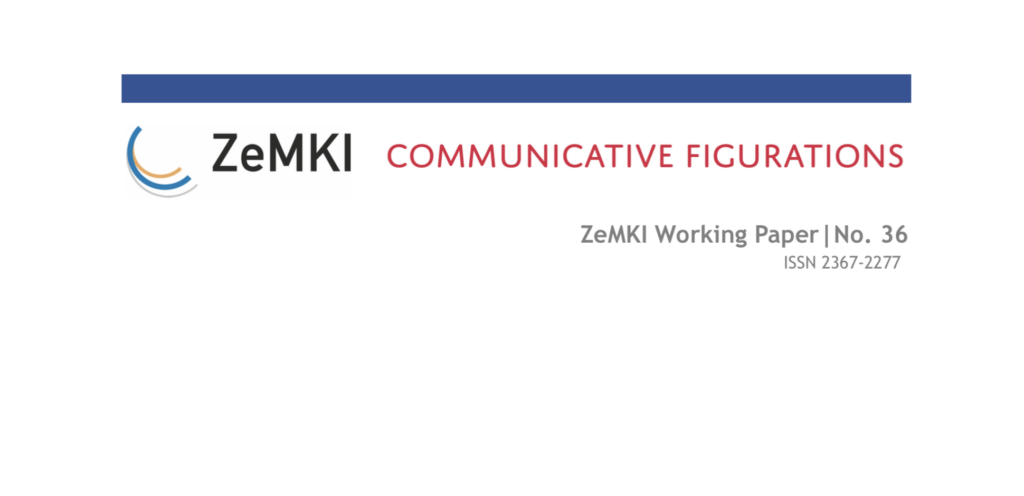
Nr. 36 - Heiko Kirschner, Anne Schmitz und Andreas Hepp: Networks of opinion leaders and heterogeneous organizations: The organizational elites of the Quantified Self and Maker Movements on Twitter
The progression of deep mediatization, that is, the molding of society by digital media and their infrastructures, is not only driven by outstanding ‘corporate actors’ such as media companies like Apple, Google, and Facebook and state agencies. Just as vital in the pro- cess are ‘collective actors’ characterized by the ways in which they ‘act on media’ (Hepp, 2020a; Kannengießer & Kubitschko, 2017: 1): These collectivities make media and the in- frastructures that undergird them the focus of their engagement, precisely because the latter have become so relevant to society. Social movements such as the Open Source or Indymedia movements that ‘act on media’ have a long legacy of scholarly attention, how- ever, pioneer communities such as the Quantified Self (QS) and Maker movements have not yet been examined more closely in this respect: While the QS movement is concerned with digital practices of self-measurement and self-optimization through the intensive use of wearables and other tracking technologies, the Maker movement is characterized by the collaborative development of (digital) manufacturing processes based on 3D printers or micro-computers such as the Arduino and the RaspberryPi.
Both pioneer communities share with social movements their open structure and their aim to stimulate societal change. The difference is that pioneer communities – even if they re- fer to themselves as a movement – share many more traits with the commercial world and established politics and are curated by an organizational elite that can be traced back to the San Francisco Bay Area (Hepp, 2020a: 33-40). In the case of the QS movement, their main curatorial instruments are publications such as Wired magazine and the QS Lab Berkeley website “quantifiedself.com”, events such as QS conferences, meetups, and pro- totyping institutions (for example, the Quantified Self Institute in Groningen, the Nether- lands). In the case of the Maker movement, these instruments include publications such as Make: magazine, or events like Maker Faires and meetings in local makerspaces.
However, besides these particular curatorial forms, online networking operates as a vital function for keeping these pioneer communities together transnationally. In both commu- nities, their organizational elite, that is, their principal organizers and decision makers, connect on Twitter to share the latest information and to make announcements. It is this online networking that will be the focus of this article to deepen our understanding of pio- neer communities and their transnational spread.
About the authors
Heiko Kirschner (heiko.kirschner@uni-bremen.de)
Heiko Kirschner has been working as a researcher (project employee) at the Center for Communica- tion, Media and Information Sciences (ZeMKI) at the University of Bremen since May 2018 in the DFG- funded project “Pioniergemeinschaften: The Quantified Self and Maker Movement as Collective Actors of Deep Mediatization”. Previously, he was Research Assistant at the Human-Drone Interaction Lab at the University of Southern Denmark (SDU) and researcher in the DFG-funded project “Mediatisierung als Geschäftsmodell III” (Priority Programme 1505 Mediatized Worlds) at the University of Vienna. After completing his master’s degree in social science innovation research at the TU Dortmund, he was a research assistant at the Chair of General Sociology at the TU Dortmund and assistant in the DFG-funded project “Scopic Media” (Priority Programme 1505 Mediatized Worlds) at the University of Constance.
Anne Schmitz (anne.schmitz@uni-bremen.de)
Since May 2018 Anne Schmitz is a research associate at the Center for Communication, Media and Information Sciences (ZeMKI) at the University of Bremen in the DFG-project „Pioniergemeinschaften: Die Quantified-Self- und Maker-Bewegung als kollektive Akteure tiefgreifender Mediatisierung“. Pre- viously she completed her master studies in Journalism and Communication Science at the University of Hamburg and the University of Aarhus. In her master thesis she analyzed the instant-messenger Snapchat and its significance in digital journalism. During her master studies Anne Schmitz worked at the Hans-Bredow-Institut for Media Research at the University of Hamburg in projects on system- atic content analysis of user comments for journalists (“SCAN”) as well as on data journalism. Fur- thermore she contributed in the research network “Communicative Figurations” – a joint initiative between the Universities of Bremen and Hamburg.
Andreas Hepp (andreas.hepp@uni-bremen.de)
Andreas Hepp is Professor of Communication and Media Studies with a focus on Media Culture and Communication Theory at ZeMKI, Centre for Media, Communication and Information Sciences, of which he is the spokesman. From 2004 to 2005 Andreas Hepp was an Assistant Professor of Cultural Significance of Digital Media, and from 2005 to 2010 Professor of Communication Studies at the Uni- versity of Bremen. Prior to his work at the University of Bremen, in 2003/4 he represented a profes- sorship of Communication Studies with a focus on Media Sociology and Media Psychology at the Insti- tute of Communication Studies at the Westfälische Wilhelms-Universität Muenster. From 1995 to 1997 he was a research assistant in the DFG project “Talking about television” at the University of Trier, 1999 research associate at the University of Karlsruhe (TH) in the Interdisciplinary Institute for Ap- plied Cultural Studies (IAK), 1999 to 2003 leading research assistant at the Institute for Media and Communication Studies (IfMK) of the TU Ilmenau. In addition, Andreas Hepp has taught and re- searched as a guest of those universities, as well as at the Goldsmiths College of the University of London, the Nottingham Trent University and the University of Sunderland.

